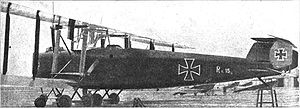D.F.W. R.II
| D.F.W. R.II | |
|---|---|

| |
| Role | Bomber |
| Manufacturer | D.F.W. |
| Designer | Dorner |
| First flight | Aug 1917 [1] |
| Introduction | no wartime use[2] |
| Primary user | |
| Number built | 2-5 [1] |
| Wingspan | 35.06 m (115 ft 0 in)[3][2]-35.3 m (115 ft 9 in)[4] |
| Propeller Diam. | 3.5 m (11 ft 6 in)[2] |
| Engine | 4×260hp Mercedes D.IVa[3] |
| Armament | 4-5 Parabellum[4] [note 1] |
| Max Speed | 132 km/h (82 mph)[4][5]-135 km/h (84 mph)[3][2] |
| Climb | 2,000 m (6,560 ft) in 58:00[3][2] 3,000 m (9,800 ft) in 53:00[4] |
| Range | 920 km (570 mi)[4] |
| Endurance | 6:00[5] to 9:10 [4] |
At least six D.F.W. R.II Riesenflugzeug giant bombers were ordered, with serial numbers R.15/15 through R.20/15.[3] R.15 first flew in August 1917[1] or 17 Sep 1917[2] but spent several months in testing and adjustment. R.16 made its first flight in May 1918 and joined R.15 during the summer.[1]
None of the R.IIs became operational during wartime. Instead the were used for training and large-plane experimentation, and only three were fully completed. R.20 was cancelled. R.18 and R.19 were planned to be finished as civil aircraft, but instead they were scrapped.[2]
For more information, see Wikipedia:DFW R.II.
References
- Notes
- Citations
- Bibliography
- Peter Gray and Owen Thetford. German Aircraft of the First World War. Great Britain, Putnam, 1962, 1987. ISBN 0-85177-809-7.
- G.W. Haddow and Peter M. Grosz, The German Giants; The German R-Planes 1914-1918. New York: Funk & Wagnalls, 2nd Ed., 1969. ISBN 9780370000374
- W.M. Lamberton and E.F. Cheesman, Reconnaissance & Bomber Aircraft of the 1914-1918 War. Great Britain: Harleyford Publications Ltd., 1962. ISBN 9780900435027